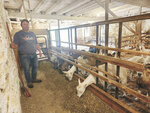


LA VALLE, Wis. — When Chad and Robin McCauley embarked on their dairy goat career seven years ago, they were told over and over again that they could not feed corn silage.
“It’s not that goats can’t eat corn silage, it’s just that most of the people that have goats can’t keep corn silage fresh enough to feed it to them,” Chad McCauley said. “They can’t feed it fast enough.”
The McCauleys had always fed baled hay and a grain mix from the mill. But when they experienced inconsistencies in the grain mix and other feed costs continued to rise, they revisited the concept of feeding corn silage to their goats.
McCauley milks 175 goats near LaValle with his wife, Robin. Chad manages the daily responsibilities on the farm while Robin works full time off the farm. They have been renting their facilities and have always tried to be conscientious about operating costs.
McCauley was determined to try feeding corn silage. He began integrating corn silage into the diet by purchasing daily amounts from a neighboring farm. He fed baled hay on one end of the bunk and corn silage topped with protein mix on the other. The goats were fed cracked corn in the parlor. Eventually, the corn was top dressed on the corn silage as well.
The goats responded well to the corn silage, with production and components increasing. McCauley continued to increase the amount fed until the farm he was sourcing from said they could not sell corn silage anymore due to dry weather conditions.
McCauley went back to feeding hay and the protein mix until he discovered a farm in Hillsboro that was making baled corn silage. The corn silage is chopped and then dumped into a compactor. It is wrapped in plastic to cure and then bale wrapped for more durable protection. It is about the size of a large round bale of hay.
McCauley purchases 10 bales of corn silage at a time, which lasts about a month. This solution resolves the freshness issue.
“This (the open top of the bale) is my face to keep fresh,” McCauley said. “Whereas with a silo, I’d have to feed a foot a day out of it.”
With a reliable source of silage available to him, McCauley’s next move was to get a more consistent product. He began by looking at total mixed ration mixers. He considered a pull-type TMR but was already making hay all summer with one tractor and did not want another implement to hook and unhook. A friend suggested feeding with a feed cart, but he did not like not being able to weigh the ingredients to create a consistent product.
Then McCauley discovered the self-propelled TMR. It has a capacity of almost 800 pounds and fits in the haymow of his barn. It combined the two concepts of pull-type TMR and feed cart in one. He worked with a local dealership to order a machine and has been using the new equipment for about three months.
Working with his nutritionist and the new equipment, McCauley was able to get his total feed costs down from $6,000 per month to $2,000 per month. This was due in part to experimenting with different supplement options in the parlor. He settled on a corn gluten pellet that was about a third of the cost of the original supplement he was feeding.
McCauley said the feed cost savings have allowed him to continue farming.
“In 2022 everything was going up and 2023 wasn’t any better,” McCauley said. “I said we can’t continue like this because we’re not making enough money. If we hadn’t switched to TMR, I probably would have had to sell out because everything was just going up in price.”
McCauley mixes feed in the haymow and unloads the TMR through a hole in the floor to the bunks below. Now that warmer weather is upon him, he is remodeling his outdoor feed bunks so he can drive by with his new TMR to feed.
Though ingredients are added by hand, McCauley can incorporate everything except the pellets into the mixer. He can mix and feed in about 1 1/2 hours.
The new system also saves on hay and bedding. The goats used to grab mouthfuls of long hay and drag it into their pens to eat. This contributed to a layer of hay on top of the sawdust bedding pack, which prevented the sawdust from doing its job.
With lower feed costs and a longer-lasting bedded pack, McCauley is glad he made the equipment upgrade and feed changes.
“Every time that I mix, it comes out the same,” McCauley said. “I’m feeding a more consistent feed and I’m not leaving my financial situation in somebody (else’s) hands.”
Comments
No comments on this item Please log in to comment by clicking here